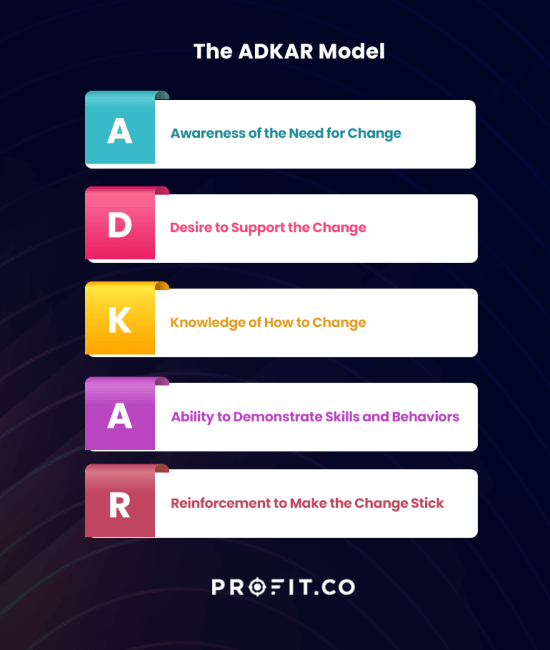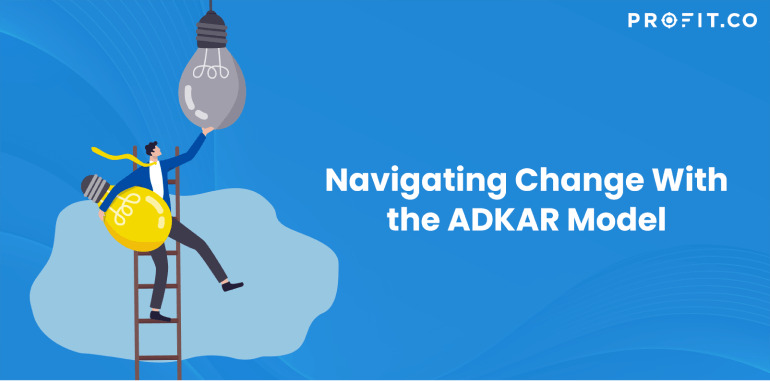The ADKAR Model is a fairly new model created by entrepreneur Jeff Hiatt with the individualistic journey of change in mind. Jeff Hiatt founded Prosci, a company centered on providing change management solutions. He has written various books about implementing a change management framework and the best model for his company.
In this model, Hiatt summarizes the key elements of the change journey and arranges them in their natural flow. The change management model, backed by over two decades of research by Hiatt’s company, aims to put together all the most common yet often overlooked realities of individual and organizational change.
By following the ADKAR model, organizations and individuals can better understand the change process and take steps to manage change and ensure successful outcomes effectively. Let’s dive into the model and learn more about how it could assist your team with navigating organizational change.
The people who are crazy enough to think they can change the world are the ones who actually do.
How the ADKAR Model Works
The ADKAR Model’s foundation lies in the five building blocks of change. Hiatt’s company says these building blocks are so “easy to learn” that they feel almost like common sense. By formulating the ADKAR Model, Hiatt provides a ready language and framework for those who need to define the journey to change step by step.
The name of the model is an acronym for the five building blocks:
A — Awareness of the Need for Change
D — Desire to Support the Change
K — Knowledge of How to Change
A — Ability to Demonstrate Skills and Behaviors
R — Reinforcement to Make the Change Stick
Awareness of the need for change
Tackling the awareness that you need change is always the first step in the journey. It creates the foundation and sets the tone for future efforts to make and implement the change. Awareness of the need for change is crucial at the individual or organizational level. It represents the individual or team’s understanding of what is about to happen and what effect this change will bring them.
In this stage, individuals or organizational leaders are encouraged to ask themselves why change is needed and explore its pros and cons.
Desire to support the change
Going through change is always difficult and may often be resisted. Just because you think the group needs the change does not mean everyone else agrees. That is why, to be a good leader in implementing change, you must create an environment that fosters the desire to support the change.
A good leader nurtures their members’ willingness to engage in the challenge of change. While desire is always a personal choice, it is the leader’s responsibility to properly communicate why this is needed and beneficial. If there is resistance, it is also essential to identify its root cause to address it.
Knowledge of how to change
Once the foundation and environment have been set, it is time to act. Implementing change is challenging, so you must know how to process and put it into reality.
In this step, you must make an implementation plan to push for the needed change and then provide your constituents with the proper knowledge and skill to carry out the responsibilities.
For change to be effective, Hiatt says it is important for the members to have the right skills to understand the change from its root, the skills to deliver and reach each milestone, and the tools to achieve the overarching goal. It is the part where everyone must be open to learning. Training and communication are necessary and one must be active in the transition.
Ability to demonstrate skills and behaviors
Once training and learning is achieved, the organization will now have the ability to tackle change. This ability comes from the previous step of gaining knowledge of knowing how to change and stems back to having the awareness and desire to change.
This is because ability does not only strictly include the specific skill sets, including motivation to carry out the necessary steps to make the transition and to maintain this change to be effective in the long run.
Reinforcement to make the change stick
After implementing change, it is always important to step back and see what you have done. In this step, Hiatt says among the steps included in this phase involve celebrating the transition’s accomplishments. This motivates people to stick to the new normal and not return to the old habits.
Also crucial in this phase is to continue collecting effective feedback from important people involved in the project, identifying pain points, and adjusting accordingly.

How it can be Applied in the Real World?
Because this simple and straightforward model is best used on transitions in large-scale companies with varying levels of understanding and capabilities. This model provides a unifying language of change and a path that people from different backgrounds can understand.
While it is a good model for large-scale transitions, it is also suitable for smaller teams that require an uncomplicated path to transitions and changes. The building blocks apply to teams of all sizes, and the steps are accessible to teams from various departments or organizations.
How can OKRs Make the Change Process More Effective?
ADKAR Change Management Model can provide a valuable framework for managing the change process. The OKR methodology can be used to set specific goals for the change and define the key results to indicate progress toward those goals. This goal-setting framework ensures that the organization is focused on achieving specific outcomes related to the change and can measure progress toward those outcomes. An OKR Change Management Program provides a structured approach to implementing the ADKAR change management model and can minimize disruption and ensure the transition is implemented smoothly and effectively.
Ready to start your change management journey today?
FAQs
- How is the ADKAR Model different from other change management models?
The ADKAR Model focuses on how change can occur from an individualistic and organizational lens. The steps are easy to follow, so much so that when you are ready for change, the ADKAR model is likened to “common sense” by founder Jeff Hiatt and is easily implemented.
- What are the five building blocks of The ADKAR Model?
A — Awareness of the Need for Change
D — Desire to Support the Change
K — Knowledge of How to Change
A — Ability to Demonstrate Skills and Behaviors
R — Reinforcement to Make the Change Stick
- Can the ADKAR Model work for a small team?
The ADKAR Model can work for companies and teams of all sizes. While it is a good model for large-scale transitions, it is also suitable for smaller teams that require an uncomplicated path to transitions and changes. The building blocks apply to teams of all sizes, and the steps are accessible to teams from various departments or organizations.
Conclusion
The ADKAR Model is built on the five building blocks of change. Utilizing these building blocks allows your company to navigate any adjustments needed easily. The ADKAR model contains all the elements of a successful Change management model. Innovation is an inevitable aspect of building a successful business, and having reliable organizational change management processes in place will help you achieve and grow your business.

